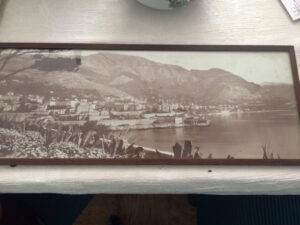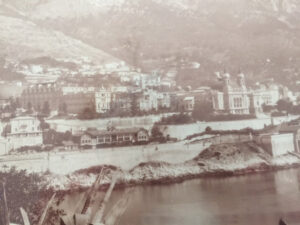 TT owns a seafront shot of an unknown location which looked to me like the French Riviera in the 1920s. I searched for a similar vintage photo of a seaside church with two spires and a Roman Style Boathouse. Boy, did I guess wrong. Come to find out the church in the photo is a kind of church, but not the religious kind. Although the jury is out on that philosophical point. That panoramic, aerial photo shows the Casino de Monte Carlo. Typically, aerial shots in 1920 fell within the purview of the armed forces, called the Girard Observers.
TT owns a seafront shot of an unknown location which looked to me like the French Riviera in the 1920s. I searched for a similar vintage photo of a seaside church with two spires and a Roman Style Boathouse. Boy, did I guess wrong. Come to find out the church in the photo is a kind of church, but not the religious kind. Although the jury is out on that philosophical point. That panoramic, aerial photo shows the Casino de Monte Carlo. Typically, aerial shots in 1920 fell within the purview of the armed forces, called the Girard Observers.
Looking for the location of the “church”
I decided not to use Google Images, but challenge my sleuthing ability. The structure resembling a Roman Boathouse had something to do with water, and in fact is part of the Oceanographic Museum. So, I kind of guessed right about both a ‘church’ and a ‘boathouse!’
The Casino de Monte Carlo serves as a complex of gambling, entertainment, and arts offices, housing the Opera de Monte Carlo and the office of the Ballets de Monte Carlo. The Société des Bains de Mer et du Cercle les Étrangers de Monaco, meaning the bathing and seaside society for strangers in Monaco, operates the whole complex. Why Strangers? Casino founders believed the locals might feel morally compromised if they worked in or gambled in the casino, so they banned them. The Casino produces revenue using foreigner’s money. Mostly the Royal Family of Monaco, who since the mid-19th century owned the founding company, receives the income.
The Woman Behind Casino de Monte Carlo
Of course a woman stands behind the genius of all this. The Princess Consort of Monaco, Maria Caroline Gibert de Lametz (1793-1879), became a Grimaldi after her marriage to Florestan I (1785-1856). When they married both performed in France, and Florestan’s plans didn’t include the throne. Shrewd and wily Marie Caroline knew her destiny as a princess.
She came up with the idea to turn the Grimaldi poverty into the Grimaldi fortunes. To do so, she amended the tax laws, and began the plan to imitate the greatest of all Casinos, the Bad Homburg. She chased the entrepreneur responsible for the Bad Homburg’s success. Over a few years she persuaded him and his ailing wife to move to Monaco, NOT Monaco as we know it today, but a place with few roads. Francois Blanc set up the plans for a great casino in 1863, with his major investors, the Bishop of Monaco and Cardinal Pecci of Monaco, the future Pope Leo XIII. Marie Caroline named the enterprise after her heir, the future Prince Charles/Carlo.
Blanc knew everybody, He lent money to the French Third Republic, allowing France to complete the great Paris Opera House. In the process he got to know the greatest Beaux Arts architect, Charles Garnier, who designed the Paris Opera House, now the Palais Garnier. His Monte Carlo designs (1878-79) became the fabulous architecture we see today, changed significantly on the inside, but the façade is Garnier’s.
Legendary Casino de Monte Carlo
 Now Monaco, with all that name implies, Casino Monte Carlo, that looks like a church, became the center of the world of high style gambling. After all, it’s James Bond’s favorite casino, seen in Never Say Never Again, and of course GoldenEye. Ocean’s Twelve happened there in 2004. And much more, such as experiments in physics. “The Monte Carlo Effect,” and various notorious gamblers who tried to beat the odds in such a palatial setting.
Now Monaco, with all that name implies, Casino Monte Carlo, that looks like a church, became the center of the world of high style gambling. After all, it’s James Bond’s favorite casino, seen in Never Say Never Again, and of course GoldenEye. Ocean’s Twelve happened there in 2004. And much more, such as experiments in physics. “The Monte Carlo Effect,” and various notorious gamblers who tried to beat the odds in such a palatial setting.
An eponymous 1892 song by vaudevillian Charles Coburn, “The Man Who Broke the Bank at Monte Carlo,” told of the discovery of an off kilter Roulette Wheel. Ben Mezrich wrote about another attempt at breaking the casino’s bank in Bringing Down the House.
The value of the photo, although it’s a silver gelatin print, is not all that high because the photo is not signed.
Pingback: Picture This: Casino de Monte-Carlo - Elizabeth Appraisals